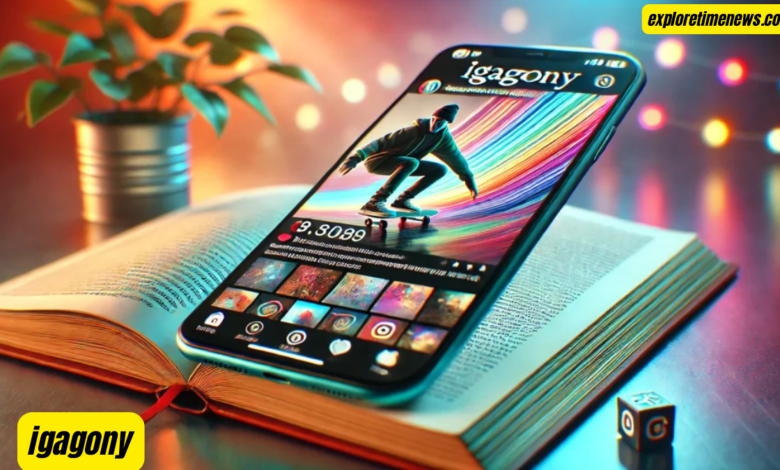
igagony In the vast digital landscape of today, new terms and trends emerge almost daily, but only a few manage to capture widespread attention. One such term that has been making waves is “agony.” If you’ve come across this intriguing word and wondered what it’s all about, you’re not alone. This article dives deep into the essence of igagony, unraveling its roots, its significance, and its broader cultural implications.
What Is Igagony?
At first glance, “igagony” may sound like a term plucked from a futuristic novel or an artistic movement. However, its origins are far simpler yet deeply rooted in the evolving digital culture. Igagony is a concept that intertwines emotional expression, social media behaviors, and the human tendency to share struggles online.
Defining Igagony: Igagony is the emotional turmoil or exaggerated anguish often expressed on digital platforms like Instagram and Twitter. It’s a blend of authentic feelings and performative acts, where users post content that reveals their struggles—either as a genuine cry for help or as an artistic portrayal of their inner world. Think of it as a digital-age version of catharsis, where pain meets aesthetics.
Why It Resonates: In an era where vulnerability and openness are celebrated, igagony strikes a chord with individuals yearning to connect on a deeper level. By showcasing their “igagonies,” people can create a sense of relatability, finding solace in knowing they’re not alone in their struggles. The term encapsulates both the rawness of human emotion and the curated nature of social media.

Examples in Everyday Life: From moody captions under grayscale selfies to poetic rants in Instagram stories, igagony manifests in countless ways. A person might post a melancholic photo with a caption like, “Lost in a sea of my own thoughts,” accompanied by a playlist of sad songs. While some may view it as performative, others see it as a form of self-expression.
The Roots of Igagony: Where It All Began
The rise of igagony didn’t happen in isolation; it’s the result of several cultural and technological shifts. To understand its origins, we need to explore the broader context of digital communication and emotional expression.
1. The Evolution of Social Media: Social media platforms started as tools for connecting with friends and family but have evolved into spaces for personal branding and storytelling. Over time, these platforms became arenas where users felt compelled to share not just their highlights but also their lows. The emphasis on authenticity paved the way for concepts like igagony to emerge.
2. The Influence of Aesthetic Trends: The “sad girl” and “dark academia” aesthetics, popularized on platforms like Tumblr and Instagram, played a crucial role in normalizing the portrayal of sorrow and introspection. These movements romanticized melancholy, making it a central theme in creative expression. Igagony borrows heavily from these trends, combining emotional depth with visual storytelling.
3. The Psychology of Sharing: Humans have an innate need to be understood and validated. Social media offers a platform to fulfill this need by allowing individuals to share their struggles and receive immediate feedback in the form of likes, comments, and shares. The dopamine hit associated with online validation reinforces behaviors like posting igagonies.
The Dual Nature of Igagony: Authenticity vs. Performance
One of the most fascinating aspects of igagony is its dual nature. On one hand, it’s a powerful tool for self-expression and connection; on the other hand, it can blur the line between authenticity and performance.
Authenticity in Igagony: For many, igagony is a genuine outlet for expressing their struggles. In a world that often glorifies perfection, sharing one’s vulnerabilities can be liberating. Posts steeped in igagony can foster a sense of community, where people come together to support each other.
Performance in Igagony: However, the performative aspect of igagony cannot be ignored. In the quest for likes and engagement, some individuals may exaggerate or even fabricate their struggles. This phenomenon raises questions about the authenticity of online interactions and the ethics of “performing” pain.
Striking a Balance: Navigating the line between genuine expression and performative acts is a challenge. While it’s important to validate people’s feelings, it’s equally crucial to encourage authenticity. Platforms and communities can play a role in promoting healthy discussions around these topics.
The Cultural Impact of Igagony
Igagony is more than just a trend; it’s a reflection of broader societal changes. By examining its cultural impact, we can gain insights into how people interact with technology and each other in the digital age.
1. Normalizing Vulnerability: One of the most positive outcomes of igagony is the normalization of vulnerability. In the past, expressing sadness or pain was often stigmatized. Today, thanks to movements like igagony, people feel more comfortable sharing their feelings openly, reducing the stigma around mental health.
2. Creating Digital Communities: Igagony has given rise to online communities centered around shared struggles and mutual support. Hashtags, forums, and group chats have become spaces where individuals can connect with others who understand their experiences, fostering a sense of belonging.
3. Critiques and Controversies: Despite its benefits, igagony has faced criticism for promoting a culture of oversharing and glorifying negativity. Some argue that it perpetuates unhealthy behaviors, while others worry about its impact on impressionable audiences. These critiques highlight the need for balance and mindfulness in digital spaces.
How Brands and Creators Are Embracing Igagony
As igagony continues to gain traction, it has caught the attention of brands and content creators. From marketing campaigns to influencer collaborations, the concept is being leveraged in creative ways.
1. Emotional Storytelling in Advertising: Brands are increasingly incorporating elements of igagony into their campaigns to resonate with audiences on a deeper level. By showcasing real-life struggles and triumphs, they create emotionally compelling narratives that foster brand loyalty.
2. Influencers and Igagony: Many influencers have embraced igagony as part of their personal branding. By sharing their vulnerabilities, they build trust with their followers and establish themselves as relatable figures. However, this trend also raises questions about authenticity and the commercialization of personal struggles.
3. The Rise of Igagony-Inspired Products: From self-care kits to mood-based playlists, igagony has inspired a range of products designed to cater to audiences seeking comfort and connection. These products tap into the emotional aspect of igagony, offering tangible solutions to intangible feelings.
Embracing Igagony Responsibly: Tips for Navigating the Trend
While igagony can be a powerful tool for connection and self-expression, it’s essential to approach it responsibly. Here are some tips for navigating this trend in a healthy and mindful way:
1. Practice Authenticity: When sharing your igagonies, strive for authenticity. Be honest about your feelings and resist the temptation to exaggerate for the sake of engagement. Authenticity fosters genuine connections and promotes a healthier online culture.
2. Set Boundaries: While sharing can be therapeutic, it’s important to set boundaries to protect your mental health. Decide what you’re comfortable sharing and avoid oversharing sensitive information that could leave you feeling vulnerable.
3. Support Others: If you come across someone’s igagony post, offer support and empathy. A kind comment or message can go a long way in making someone feel understood and valued.
4. Balance Online and Offline Life: Remember that social media is just one part of your life. Make time for offline connections and activities that bring you joy and fulfillment.
Conclusion: The Legacy of Igagony
Igagony is more than just a fleeting trend; it’s a testament to the evolving nature of human expression in the digital age. By blending raw emotion with aesthetic appeal, it captures the essence of modern vulnerability. Whether you view it as a genuine outlet or a performative act, there’s no denying its impact on how we communicate and connect.
As we continue to navigate the complexities of the digital world, igagony serves as a reminder of the power of emotion and the importance of authenticity. By embracing this trend responsibly, we can foster a culture of empathy and understanding, both online and offline.